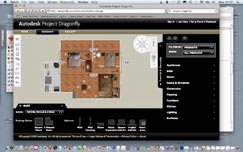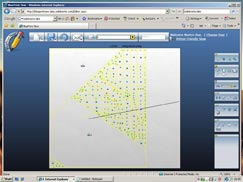In the future, all design software might be run in a web browser, and workstations may never need RAM, graphics or hard drive upgrades. However, as Martyn Day found out while researching this article, the future is already here
We all know that ‘everything is going online’. From ordering groceries, to finding a life-partner it now seems more possible than ever to stay indoors and never leave the house. We have quickly adopted ‘digital lifestyles’ and have pretty much taken for granted what the Internet has done for us. However, some new technology revealed this month got me thinking about how the Internet could fundamentally change the way we use, access and pay for our design tools in the not too distant future.
While browsing the BBC news site I came across a story about a new company called Onlive (www.onlive.com), which later this year, will offer an almost unbelievable online service to computer game fans. Onlive will host the games on its top-of-the-range servers and workstations and blast the graphics to a web browser running on any operating system or TV. As you are not actually running the program, this means that you don’t have to have a high-specification computer to get the best experience and never have to download the games, which these days are huge. This got me thinking, if they can do that for a 60 frames per second game, they can surely do that for a CAD application?

Onlive’s web-based technology, which uses a custom on-the-fly decoder and controller to interact with remotely hosted games, could also be adapted to deliver CAD over the web
I did some further reading on other newswires and it seems that even the stock market took notice (for once) and there were analysts claiming that if Onlive worked it could even be the death of the Sony PlayStation or Microsoft Xbox. You would never need to have a specific games console, or ensure you have the latest graphics card, oodles of RAM or an expensive processor in your PC…. in fact you could downgrade! You would get the same performance on an ATOM-based ultra portable, as you would on a Intel quad core Xeon. Performance would depend solely on the ‘breadth’ of your Internet bandwidth.
ONLIVE TECHNOLOGY
For those of you not into games, bear with me, it’s the underlying technology principle that’s up for discussion. In the last seven years, Onlive claims to have perfected an interactive video compression technique, with ultra low latency (lag) – it literally encodes video into data in one millisecond. This has been incorporated into a custom processor, which comes in a box you acquire as part of your subscription, with a software plug-in for browsers.
If you have a 1.5 Mbit connection speed you would see real-time Wii resolution but with a 4.5 Mbit Internet speed, Onlive is promising to deliver 1,280 x 720 at 60 frames per second. Onlive has already signed up the major software vendors: EA, Ubisoft, Eidos, Atari, Codemasters and THQ to name but a few, and is due to go live in September 2009 in the US.
If it works, this really could be an industry-changing technology. There are many different attempts to try and incorporate 3D libraries in the browser to enhance 3D web content but this would still rely on the graphics card in the machine you have and the grunt of your workstation’s processor. Onlive would remove this hardware overhead for the user by just streaming the application’s video output.
We have seen similar technology delivered by HP with its Blade workstations, which operate as a thin-client. The workstations can be kept at a remote location but accessed via a simple terminal over a TCP/IP network. Onlive expands this concept by doing it over the public network (the Internet). The modern term for this is Cloud Computing.
CAD ONLINE
This Onlive technology surely must be interesting to CAD developers who all have some experimental web-based solutions at various stages of development? Indeed, I’ve just returned from Autodesk’s offices in San Francisco where I raised Onlive as a talking point, to which I was told that Autodesk was one of the less visible but strategic investors in the company! Knowing what web tools Autodesk has been experimenting with on its labs website (labs.autodesk.com), Onlive is a perfect fit.

Project Dragonfly is one of the slickest web-based design applications we have seen. Currently on Autodesk’s Labs it can be used to space-plan offices or homes
Standard Web browsers are really very poorly 3D endowed; they don’t make a great place for 3D graphics applications unless you add a plug-in or two, of which there are now many. It’s perhaps not surprising that our industry couldn’t agree on a standard but there are five ‘open’(ish) popular development tools:
VRML now reworked as a new standard, called X3D.
3DMLW – 3D Markup Language for Web.
COLLADA – COLLAborative Design Activity.
Open GL ES 2 – a variant of Open GL.
U3D – Universal 3D, originated by Intel.
Having given you two milliseconds to digest those industry 3D standards, I’m going to add in some more jargon and mention RIA – Rich Internet Applications. This is an industry buzzword for providing enhanced development tools for browser or web-driven applications. Microsoft is pushing a .NET technology called Silverlight, while Adobe has AIR. These frameworks expand what it is possible to develop within browsers and provide web-tools with most of the benefits of desktop development tools, such as data persistence, access to locally stored data and application integration capabilities.
All these 3D standards and additional programming layers provide hooks for the CAD developers to produce web-based applications which access the 3D graphics and other hardware in your machine. So, even before becoming a reality, Web applications are moving beyond the browser and now appear to be hybrid applications. A little known fact is that a lot of this is being driven by modern phone operating systems, as developers need tools which will deliver applications for multiple target platforms, from low-power and thin-client to heavy workstation and servers – the focus is moving away from desktop applications to Internet-enabled tools.
On the CAD tool side of the tracks, everything at this stage seems quite experimental at the moment but eventually the right combinations will create firm standards and open up rich web-based applications. That is, of course, unless cloud computing and video compression systems such as Onlive don’t bypass these current software development limitations.
While Onlive isn’t even running (outside of beta), there are some impressive web-enabled CAD tools which already show what’s capable with today’s cutting edge add-on 3D web technology. Autodesk’s Project Dragonfly (dragonfly.autodesk.com) appears to be one of the more advanced web-based Labs applications that I have seen so far, where users can design interior layouts and spaces using drag and drop and axonometric views. While it’s architectural, it’s well worth trying out to see how fast it works as a browser-only based application. There are a number of other tools in development: Project Showroom – a cloud-based rendering tool for visualising interior fittings and colours, as well as Project Freewheel for DWG viewing in a web browser.

SolidWorks Blueprintnow technology enables users to upload, display and edit DWG files with a browser
SolidWorks also has a web-based DWG viewer, editor and creation tool called SolidWorks Blueprintnow (labs.solidworks.com). It’s fun to try out and use as a DWG viewer but not particularly usable as an accurate drafting tool yet. SolidWorks also offers a number of web-based file distribution and collaboration technologies on its labs website.
At the moment we don’t really have any serious commercial attempts at providing even a 2D drafting tool, let alone a proper 3D solution. It would be interesting to see the capabilities of SolidWorks, Inventor, Pro/E or Catia in a browser but that is probably still some years off. In fact Dassault has told me that it is working on delivering Catia online in the future but estimated 3-5 years.
Conclusion
With Onlive, the whole browser vs desktop, cloud vs client-based computing has suddenly hit home to me, with the fundamental changes that may be in store for us in the coming years. We may not need to have workstations but share part of a remote super computer. The hassle of upgrading workstation components may totally go away. We could all have ultra-lightweight, low power laptops that had battery lives of days. Fan noise would be a thing of the past!
However this is all based on one thing – the reliability of fast, cheap, Internet bandwidth and countries that don’t have the technology infrastructure are going to suffer. Even if each session took 1.5 Mbit of bandwidth, in a room of 20 engineers you would need at least a 30 Mbit pipe and while our Internet providers promise us much, they rarely, if ever deliver the bandwidth they advertise, In fact you are lucky to get 50%.
As with most technologies, the games industry will lead the charge and we, via the design tool developers, will follow. The concept that everyone gets the hottest hardware running their games irrespective of what they have at home seems incredibly liberating. The technology certainly has its doubters in the industry – however, some have a vested interest in it not succeeding.
While developing with all the 3D web tools, Autodesk appears to be ahead of the curve with its investment in Onlive. Of course, should Autodesk’s applications become hosted Cloud applications, there would be far reaching implications for dealer and distribution networks but that’s probably a different article.
{encode=”martyn@x3dmedia.com ” title=”martyn@x3dmedia.com “}

Martyn Day examines Onlive and considers its potential for CAD delivered by SaaS






